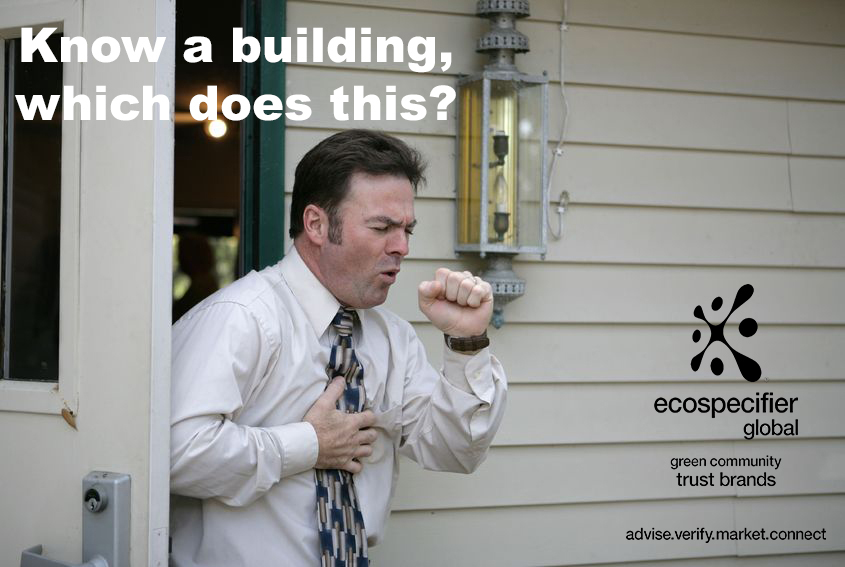Are you breathing toxic air?
A “sick” building is a structure, or room, that has become contaminated with harmful elements or chemicals.
’Sick building syndrome’ (SBS) is a concept that refers to a variety of illnesses that occupants may develop due to exposure to in- building pollution.
Indoor pollution can cause serious health risks although can generally easily be avoided.
A building’s health may be decreased over either a short or prolonged period of time from a variety of causes including:
– External pollution
– Mould and mildew or,
– Product emissions.
Poorly selected finishes in products like fittings and furniture can release gaseous toxins over a period of time, resulting in a prolonged period where a building can be classified as “sick”.
Additionally, certain activities may result in the release of toxins that decrease the health of a building, such as cleaning with products are made with compounds containing volatile toxins.
Health impacts from exposure to a sick building may depend upon a person’s age and health or sensitivity to certain compounds, as well as the level of exposure to a potentially hazardous environment.
The commonly accepted short-term health issues associated to ‘sick building syndrome’ include:
- Skin, eye and throat irritation
- Headaches
- Drowsiness
- Allergic reactions and asthma
Common long-term health impacts related to the sick building syndrome concept include:
- Cancer
- Respiratory disease
- Heart disease
SICK BUILDING CHECKLIST
A wide variety of factors can reduce the health of a building, below are just a few examples to consider as causes:
- Biological contaminants such as bacteria, moulds, mildew and house dust mites can cause a range of health effects including hypersensitivity pneumonitis, allergic rhinitis and asthma
- Stoves, heaters, fireplaces and chimneys can all release carbon monoxide and nitrogen dioxide, along with a range of other particles, which may impact your health by interfering with the delivery of oxygen throughout the body, irritating the mucous membranes in the eye, nose and throat or cause lung and tissue damage.
- Volatile organic compounds (VOCs) can be released from everyday household products, including carpets and paint, and have the potential to cause a range of health effects including irritation to the eyes, nose and throat, immune deficiency, asthma, headaches, liver and kidney damage and potentially cause cancer
- Benzene may be present in household products including glues, adhesives, cleaning products and art supplies and may result in a range of health impacts ranging from skin and eye irritation to leukaemia
- Formaldehyde a toxic chemical present in building materials, clothing and even cosmetics! The health effects of formaldehyde exposure range from nasal and eye irritation to liver and kidney damage
- Bisphenol A (BPA) is found in plastic products and can act as an endocrine disrupter posing significant health risks especially to the development of young children and babies.
HEALTHY BUILDING ACTION CHECKLIST
Whilst the potential health risks from building products and home fixtures can depend on a wide variety of personal and external factors, there are various steps that can be taken in order to improve the health of a building and reduce any associated health risks:
- Choose products from a reliable source like the Ecospecifier website (ecospecifier.com.au) which only lists third party certified and verified products that have passed health and eco-toxicity assessments
- Install weather stripping and caulking to seal the home – this can help to reduce the amount of pollution entering your home and reducing indoor air quality.
- Prevent and manage issues related to the dampness of a building to avoid the presence of mould in order to decrease the risk of being exposed to hazardous microbes;
- Eliminate smoking indoors.
- Ensure adequate indoor ventilation.
- Avoid products that contain formaldehyde or benzene.
- Look for Low-VOC paints
- Buy solid wood, hardboard or exterior grade plywood instead of pressed wood products;
- Regulate room temperature and humidity to decrease the amount of VOCs emitted;
- Choose plastic products that are BPA free.
- Use only third party certified health-safe cleaning products.
Explore more about the product ranges that have been certified and listed by Ecospecifier, by using the Product Search Engine on Ecospecifier Global: http://www.ecospecifier.com.au
Join us in more conversations about green products and sustainability issues on our social media pages:
Follow Ecospecifier on Facebook
Follow Ecospecifier on Twitter
Follow Ecospecifier on LinkedIn
Join our Social Media Honour Roll – support the switch to green products
Like, Comment and Share our blogs and posts on your social media pages … and we will send your name out to more than 15,000 subscribers via our monthly Ecospecifier Global Newsletter.
See which stellar individuals, businesses and networks made the latest Honour Roll on Twitter and Facebook HERE We salute you in helping us educate and help more people #MaketheSwitch to #EcoResponsible products.
